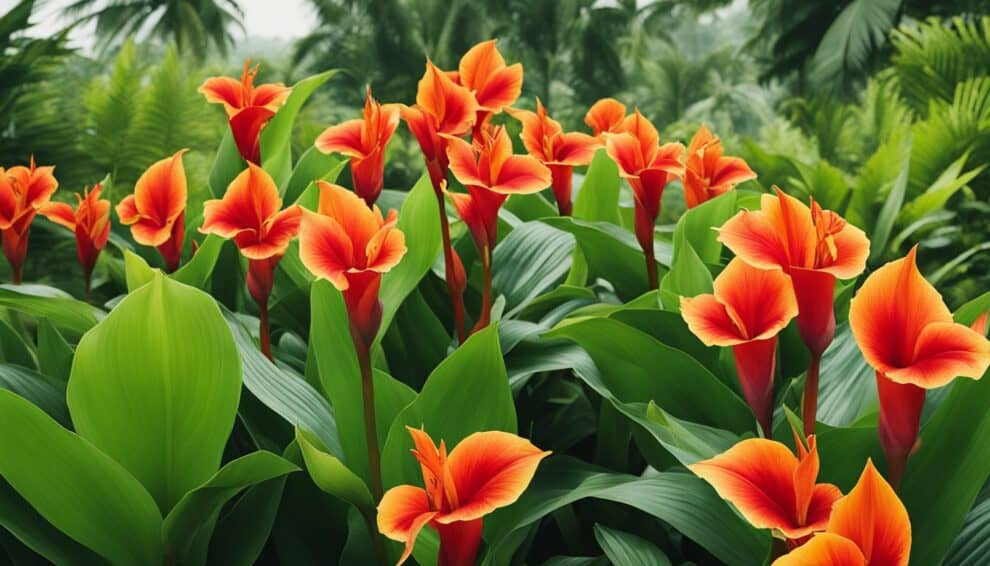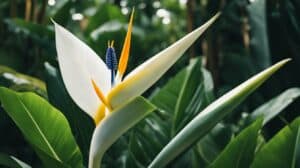Canna Lily, a tropical plant known for its vibrant foliage and flowers, is a popular choice among gardeners and horticulturists.
The plant belongs to the Cannaceae family, which includes approximately 10 species of flowering plants.
Canna Indica, also known as Indian Shot, is one of the most commonly cultivated species of Canna Lily.

Canna Indica is native to Central and South America and is widely cultivated for its ornamental value.
The plant can grow up to six feet tall and features large, glossy leaves that come in a range of colors, including green, bronze, and purple.
Canna Indica also produces showy flowers that come in shades of red, orange, yellow, and pink.
The flowers are often used in cut flower arrangements and can last for several weeks.
In addition to their aesthetic appeal, Canna Lily plants are also valued for their medicinal properties.
Canna Indica Origins

Historical Background
Canna Indica, commonly known as Indian Shot or Canna Lily, is a tropical plant that is native to South America.
The plant was first discovered by European explorers in the early 16th century, and it quickly became popular due to its beautiful foliage and flowers.
During the Victorian era, Canna Indica was widely cultivated in Europe and North America as an ornamental plant.
Geographical Spread
Canna Indica is now widely distributed throughout the tropics and subtropics of the world.
The plant has been introduced to many countries, including India, China, Japan, Australia, and parts of Africa.
In some regions, Canna Indica has become naturalized and is considered an invasive species.
Canna Indica is a member of the Cannaceae family, which includes about 10 genera and around 70 species.
The plant is known for its large, colorful flowers and striking foliage, which can range from green to purple to variegated.
Canna Indica is also valued for its medicinal properties, and it has been used for centuries in traditional medicine to treat a variety of ailments.
Overall, Canna Indica is a fascinating and beautiful plant with a rich history and a wide geographical spread.
Whether grown for ornamental or medicinal purposes, this tropical plant is sure to delight and inspire gardeners and plant lovers around the world.
Botanical Characteristics

Anatomy of Canna Indica
Canna Indica, commonly known as Canna Lily, is a tropical plant with large, broad leaves and vibrant flowers.
The leaves are arranged in an alternate pattern and can grow up to 1 meter in length.
They are typically green in color, but some varieties have reddish or purplish hues.
The flowers of Canna Indica are showy and come in a range of colors, including red, orange, yellow, and pink.
They are borne on tall stalks that can reach up to 2 meters in height.
The flowers of Canna Indica have a unique structure that is adapted for pollination by insects.
The petals are fused together to form a tube, which contains the reproductive organs of the plant.
The stamens and pistil are located inside the tube, and the nectar is produced at the base of the flower.
This structure attracts a variety of pollinators, including bees, butterflies, and hummingbirds.
Growth Habits
Canna Indica is a perennial plant that grows from rhizomes. The rhizomes are thick, fleshy roots that store nutrients and water for the plant.
They can grow up to 30 cm in length and 5 cm in diameter. The plant can grow in a variety of soil types, but prefers well-drained, fertile soil.
Canna Indica is a fast-growing plant that can reach its full height in just a few months.
It is tolerant of heat and humidity, and can grow in full sun or partial shade. The plant requires regular watering, especially during periods of drought.
In conclusion, Canna Indica is a beautiful and unique tropical plant with broad leaves and vibrant flowers.
Its anatomy is adapted for pollination by insects, and it grows quickly from rhizomes in a variety of soil types.
Cultivation and Care
Planting Guidelines
Canna Indica thrives in warm, tropical climates and requires full sun exposure.
It can be planted in the ground or in containers, but it is important to ensure that the soil is well-draining and rich in organic matter.
The best time to plant Canna Indica is in the spring, after the last frost has passed.
When planting in the ground, dig a hole that is twice as wide and deep as the plant’s root ball.
Place the plant in the hole and backfill with soil, ensuring that the top of the root ball is level with the soil surface.
When planting in containers, choose a pot that is at least 12 inches in diameter and fill it with a well-draining potting mix.
Watering and Feeding
Canna Indica requires regular watering, especially during periods of drought.
However, it is important not to overwater the plant, as this can lead to root rot.
Water the plant deeply once a week, ensuring that the soil is moist but not waterlogged.
Fertilize the plant every two weeks during the growing season with a balanced fertilizer. This will help promote healthy growth and vibrant blooms.
Be sure to follow the instructions on the fertilizer package, as over-fertilizing can damage the plant.
Pest and Disease Management
Canna Indica is generally a hardy plant that is not susceptible to many pests or diseases.
However, it is important to keep an eye out for spider mites, aphids, and mealybugs, which can occasionally infest the plant.
If pests are present, treat the plant with a mild insecticide or a solution of water and dish soap.
Be sure to follow the instructions on the insecticide package and avoid using harsh chemicals that can harm beneficial insects.
Canna Indica can also be susceptible to fungal diseases, such as leaf spot and powdery mildew.
To prevent these diseases, avoid overhead watering and ensure that the plant has good air circulation.
If disease is present, treat the plant with a fungicide and remove any infected leaves.
Uses and Symbolism

Ornamental Uses
Canna Indica, with its lush foliage and vibrant flowers, is a popular choice for ornamental gardening.
Its large leaves, which can grow up to 2 meters in height, make it an excellent choice for creating a tropical ambiance in gardens and landscapes.
The flowers of Canna Indica come in a range of colors, including red, orange, yellow, and pink, making it a versatile plant for adding color to any garden.
Canna Indica is also commonly used as a potted plant, making it an ideal choice for indoor gardening.
Its low maintenance requirements and ability to thrive in a range of lighting conditions make it an excellent option for those looking to add a touch of tropical flair to their homes.
Cultural Significance
Canna Indica has a long history of cultural significance, particularly in South and Central America, where it is native.
In many cultures, the plant is believed to symbolize fertility and abundance.
It is often used in traditional medicine for its purported healing properties, and its roots and rhizomes are used to make a range of remedies.
In Hindu culture, Canna Indica is associated with the goddess Kali, who is often depicted holding a Canna Lily.
In this context, the plant is seen as a symbol of fertility, prosperity, and purity.
In some African cultures, Canna Indica is used in rituals and ceremonies as a symbol of spiritual protection and purification.
The plant is believed to have the power to ward off negative energy and promote positive energy flow.
Overall, Canna Indica’s lush foliage and vibrant flowers make it a popular choice for ornamental gardening, while its cultural significance adds a layer of depth and meaning to its use.
Frequently Asked Questions

How do I care for my Canna Lily to ensure it blooms beautifully?
Canna Lilies are low-maintenance plants that require minimal care to bloom beautifully.
To ensure healthy growth and abundant blooms, it is important to provide your Canna Lily with well-draining soil, plenty of sunlight, and regular watering.
Deadheading spent blooms and removing any damaged or yellowing leaves can also promote new growth and encourage more blooms.
What are the ideal growing conditions for Canna Indica plants?
Canna Indica plants thrive in warm, tropical climates with plenty of sunlight and moderate humidity.
They prefer well-draining soil that is rich in nutrients, and should be watered regularly to keep the soil moist but not waterlogged.
Canna Lilies can also benefit from occasional fertilization with a balanced, all-purpose fertilizer.
Can Canna Lilies thrive in colder climates, and how can I protect them during winter?
While Canna Lilies are tropical plants that prefer warm weather, they can still thrive in cooler climates with proper care and protection.
In colder regions, it is important to dig up the bulbs and store them indoors during the winter months to protect them from frost and freezing temperatures.
The bulbs can be stored in a cool, dry place and replanted in the spring once the weather warms up.
What are some common pests or diseases that affect Canna Lilies, and how can I prevent them?
Canna Lilies are generally resistant to pests and diseases, but they can still be susceptible to certain issues.
Common pests that can affect Canna Lilies include aphids, spider mites, and thrips, while diseases such as fungal leaf spot and bacterial blight can also be a concern.
To prevent these issues, it is important to maintain good hygiene practices, such as removing any dead or decaying plant material, and to provide your Canna Lily with proper care and growing conditions.
How often should I water my Canna Lily, and does it have specific soil requirements?
Canna Lilies require regular watering to keep the soil moist but not waterlogged.
In general, they should be watered once or twice a week, depending on the weather and soil conditions.
Canna Lilies prefer well-draining soil that is rich in nutrients, and can benefit from occasional fertilization with a balanced, all-purpose fertilizer.
What are the best ways to propagate Canna Indica for my garden or landscape?
Canna Indica can be propagated through division, which involves separating the bulbs and replanting them in new soil.
This can be done in the spring or fall, and can help to promote healthy growth and abundant blooms.
Canna Lilies can also be propagated through seed, although this method can be more challenging and may not produce consistent results.














